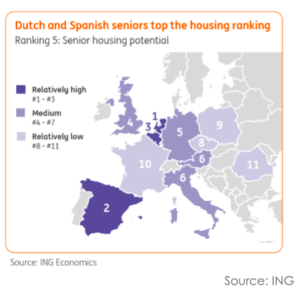
Steven Zeeman, Managing Partner Life Europe
Steven Zeeman is Managing Partner Life Europe, an institutional start-up platform founded in 2019. Noticing the shortage and complexity of senior living across Europe, Steven initiated the Hamlet Living project, a mixed co-living environment for elderly people that have reached 65 years. Hamlet’s premise starts with the idea that independent living privacy can be combined with a huge appetite for a more serviced oriented residential and care concepts. Coworking operators are familiar with this philosophy and concepts, that is why we wanted to know more about the co-living for elderly people approach Hamlet is developing to vet an impression: hospitality models are embracing the real estate industry way beyond the workplace segment.
Hi Steven. The rise of co-living for elders illustrates the growing importance of hospitality approaches in Real Estate. Would you agree?
This is a trend you see in all real estate categories. The low hanging fruits were students, young professionals and expats – basically everybody under age of 40 without kids. Nowadays, we observe 65+ qualify for those new co-living services too; kids have left home, some consider to sell the family house… That being said, this generation appears more segmented than the younger ones. According to an ING survey, one out of three European seniors would consider moving to forms of housing for the eldery with centralised support or care. Even in countries that make relatively little use of senior housing, at least 25% of the eldery is receptive to organized senior housing at scale. That’s why investment volumes are rapidly increasing.
The low hanging fruits were students, young professionals and expats – basically everybody under age of 40 without kids. Nowadays, we observe 65+ qualify for those new co-living services too.
What are the reasons behind this trend in the real estate industry?
 Take The Netherlands: the Babyboom generation is now 75+. We have 1.3 million elders. More than 2 million will be expected by 2030. The traditional nursing homes are outdated and often not attractive options for young seniors. They rather accompany seniors in their sickness. They rarely offer modern housing, social experiences and care comfort for a happy life. Senior housing using co-living concepts offer an alternative. They focus on elders’ well-being and care (when needed) while creating independent senior living apartments at scale to allow for attractive shared amenity space complemented with attractive activities. Our main idea at Hamlet project is to create a place for active seniors where they can have a socially engaging life as individuals in an interesting setting close to other people, leisure, retail and cultural activities. “A little village in the city” is our main statement. This approach should lower loneliness and reduce pressure on today’s medical system.
Take The Netherlands: the Babyboom generation is now 75+. We have 1.3 million elders. More than 2 million will be expected by 2030. The traditional nursing homes are outdated and often not attractive options for young seniors. They rather accompany seniors in their sickness. They rarely offer modern housing, social experiences and care comfort for a happy life. Senior housing using co-living concepts offer an alternative. They focus on elders’ well-being and care (when needed) while creating independent senior living apartments at scale to allow for attractive shared amenity space complemented with attractive activities. Our main idea at Hamlet project is to create a place for active seniors where they can have a socially engaging life as individuals in an interesting setting close to other people, leisure, retail and cultural activities. “A little village in the city” is our main statement. This approach should lower loneliness and reduce pressure on today’s medical system.
Our main idea at Hamlet project is to create a place for active seniors where they can have a socially engaging life as individuals in an interesting setting close to other people, leisure, retail and cultural activities. This approach should lower loneliness and reduce pressure on today’s medical system.
Residence for elderly people is not a new thing. Why can one speak about co-living, here?
To us, one key dimension is to create an interesting dynamic among the residents so that they are not lonely and feel at home. You need real onsite people for that. You could compare that role with the role of a community manager in a coworking space, for instance. In order to activate the residents, Hamlet on-site hospitality team, service providers, residents themselves and volunteers are essential to activate and include the seniors, increase their health and well-being living a normal life. This can drastically reduce medical costs, for instance. That’s the main difference we see between a residence for eldery senior people and a co-living concept.
To us, one key dimension is to create an interesting dynamic among the residents so that they are not lonely and feel at home. This can drastically reduce medical costs.
Do you see a common source of inspiration between co-living for elderly and coworking spaces?
 Co-living and coworking spaces fit with the needs of the moment. They take into account the critical balance between private and shared spaces (e.g. office with sole open space are not successful, as people need private concentration rooms as well). Bringing flexibility, service, content and intention in a building becomes a rising demand. The new generation of senior housing, for instance, will be sizeable and adaptable (i.e: flexible walls allow for living together separately when one partner needs more care or rest, high speed WIFI allowing for all modern robotica to be installed when desired). More broadly speaking, this approach will become a must in a growing portion of any real estate asset, would that be for an audience of elderly people in the case of retirement homes, an audience of students with the development of modern co-living students houses, or and audience of workers in the case of coworking spaces.
Co-living and coworking spaces fit with the needs of the moment. They take into account the critical balance between private and shared spaces (e.g. office with sole open space are not successful, as people need private concentration rooms as well). Bringing flexibility, service, content and intention in a building becomes a rising demand. The new generation of senior housing, for instance, will be sizeable and adaptable (i.e: flexible walls allow for living together separately when one partner needs more care or rest, high speed WIFI allowing for all modern robotica to be installed when desired). More broadly speaking, this approach will become a must in a growing portion of any real estate asset, would that be for an audience of elderly people in the case of retirement homes, an audience of students with the development of modern co-living students houses, or and audience of workers in the case of coworking spaces.
Bringing flexibility, service, content and intention in a building becomes a rising demand. It will become a must in a growing portion of any real estate asset, would the audience be elderly people in the case of retirement homes, students in modern co-living students houses or workers in the case of coworking spaces.
Are traditional legal real estate frameworks ready for co-living and coworking concepts?
 Rental regulation, tax laws and building codes need adjustment for the blending of real estate and operational concepts. For us, this is a case by case analysis making it very difficult in certain places to create the product residents would want. For instance, we like the idea of mixing coworking/meeting centers, guesthouse, café/bars, etc. to initiate a socially engaging work/living environment which also adds value to the development of that area and supports the concept of shared economy and sustainability. In an urban setting it may not be a requirement as all those services can be found close by, but in rural areas this can be a problem. The regulation should be more flexible.
Rental regulation, tax laws and building codes need adjustment for the blending of real estate and operational concepts. For us, this is a case by case analysis making it very difficult in certain places to create the product residents would want. For instance, we like the idea of mixing coworking/meeting centers, guesthouse, café/bars, etc. to initiate a socially engaging work/living environment which also adds value to the development of that area and supports the concept of shared economy and sustainability. In an urban setting it may not be a requirement as all those services can be found close by, but in rural areas this can be a problem. The regulation should be more flexible.
We like the idea of mixing coworking/meeting centers, guesthouse, café/bars, etc. to initiate a socially engaging work/living environment which also adds value to the development of that area.
How should operators address the challenge?
In my experience it makes a difference if you approach local authorities as mere real estate developers, or as a service provider that depends on creating an attractive local ecosystem in the long run. As the latter, you can show all the positive externalities that your project creates in the neighbourhood, which makes any discussion easier.
How do you see the role of concepts like yours in city-ecosystems of the future?
Very necessary. We can hopefully contribute to society by lowering care costs (healthy and active residents that help each other), finding appropriate housing solutions so seniors do not keep family homes occupied for the next generation, creating new social centers for people to meet, live, share… That would be something to be really proud of!
Join Coworking Europe Conference for more insights, data and connections!




0 Comments